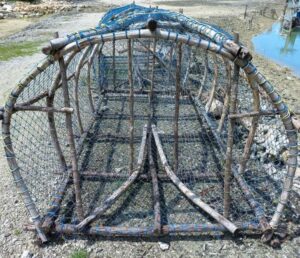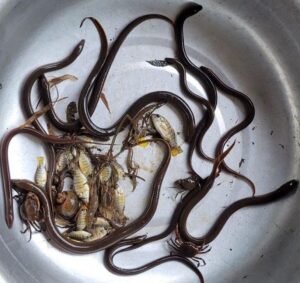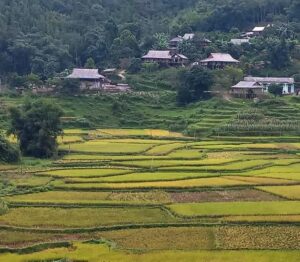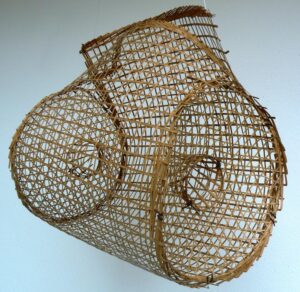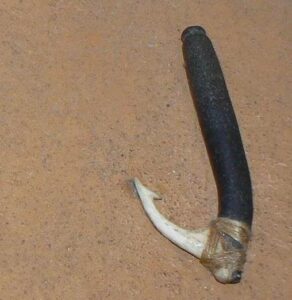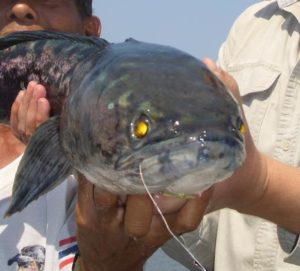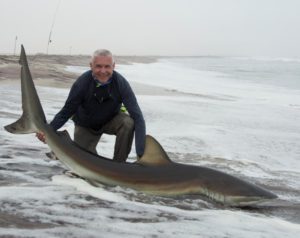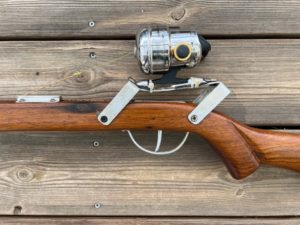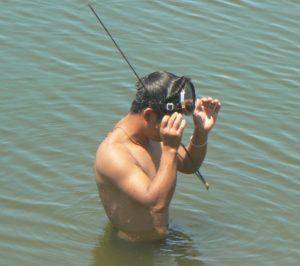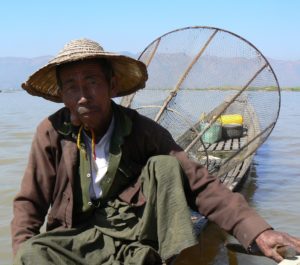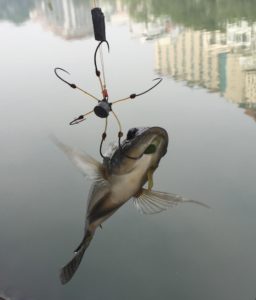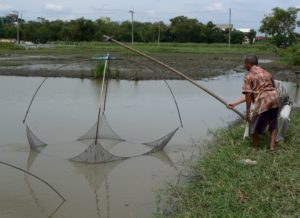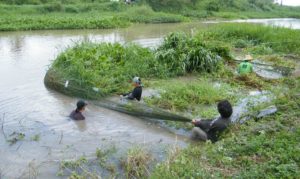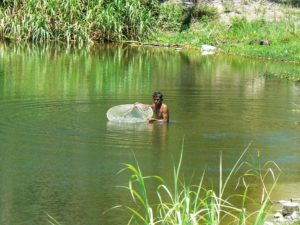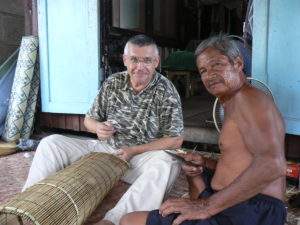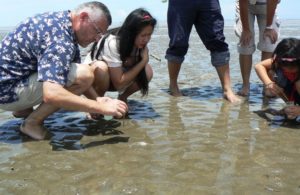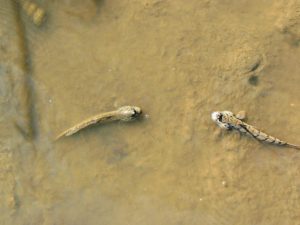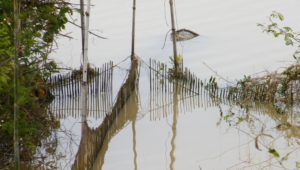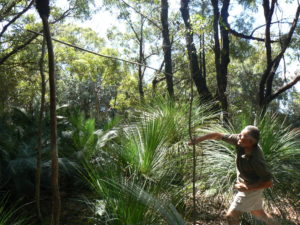Fishing
Bottom fish traps of the Urak Lawoi people
The following information was gathered from a Urak Lawoi man who has lived in the Rawai Beach Sea-Gypsy Village for 27 years. He was 57 years old and only had one tooth (incisor) left in the middle of his upper…
Rectangular squid traps in Thailand
Rectangular squid traps are used in the Gulf of Thailand and along the coastline of the Andaman Sea in the same way as semi-circular traps. Both types are primarily used for catching Bigfin reef squid (Sepioteuthis lessoniana) but will also…
Trapping eels in Northern Vietnam
Trapping eels is a simple way for rice farmers in the catchment area of the Red River in North Vietnam to provide themselves with animal protein. No special skills are required, as with angling or net fishing. The activity is…
Animal species collected by rice farmers in the Red River Delta
Rice farmers in secluded areas of the Red River Delta in Northern Vietnam need dietary additions to their staple rice dishes. Vegetables are harvested from around their homes and surrounding tropical Evergreen forests. Animal proteins are mainly collected in and…
Building a specialized fishing boat at Padang
In Indonesia, there exists a wide variety of traditional fishing boat designs. Most of them are variations of standard types, which were adapted to local needs and conditions. And many of them are not systematically described yet. This article tries…
Trapping Snakeskin Gourami in the Mekong Delta
Trapping Snakeskin Gourami fish (Trichopodus pectoralis) is commonly done all over Southeast Asia. However, a specific trap for catching them was developed in the Mekong Delta in Vietnam. Its simple principle could be easily applied to many other areas of…
Catching Octopuses by Sea-Gypsies
Sea-Gypsies – Urak Lawoi, Moklen, or Moken – traditionally catch octopuses along the Andaman Sea’s rocky shores. Using a metal skewer and baited bamboo stick, they locate octopuses in holes with foam or clean pebbles. Patiently baiting them, they impale…
Three-spot swimming crabs on surf-beaten sandy beaches
Description of the crab species Three-spot swimming crabs (Ovalipes trimaculatus) have a rounded triangular carapace with five legs on either side. The tips of the back pair of legs are flattened into paddles for better maneuvering in the water. Adorned…
Neolithic fishhooks in Korea
During the Neolithic Age (8000 BCE – 1400 BCE), people across various regions began to adapt to the evolving natural environment following the Ice Age. This era is characterized by the emergence of earthenware artifacts and groundstone tools, as well…
Using a stomping basket to catch fish in Vietnam
Fishing with a stomping basket is a traditional craft that has been practiced in Vietnam for centuries. Postcards from the French colonial era depict this unique fishing method as a typical way for locals to catch fish. While similar techniques…
Giant Snakehead fishing in Thailand
The Giant Snakehead fish (Channa micropeltes) is a highly aggressive and predatory freshwater fish. Its diet mainly consists of smaller fish, frogs, crustaceans, and other aquatic prey. In Malaysia, Singapore, and Indonesia, this fish is known as the ‘Toman’ and,…
Shore fishing for Bronze Whaler Shark
Bronze Whaler Sharks (Carcharhinus brachyurus), also known as Copper Sharks, are a sought-after game fish for recreational anglers in many parts of the world. They are known for their impressive strength and fighting abilities, which pose a challenge for anglers….
Catching Tigerfish at the Zambezi
Tigerfish hold a similar significance for Africans as the bass does for Americans or carp do for Europeans. These three fish species effectively represent the human populations on their respective continents. Personally, tigers are my favorite among them, as they…
Limpets on rocky shorelines
Limpets (Scutellastra sp. and others) have conical, oval-shaped shells that range from 1-10cm in diameter depending on the type of limpet. Their shell is ribbed or smooth depending on the limpet species. The shells are normally brown, grey, or black…
Description of a speargun for freshwater fishing
In the following, we will briefly describe a specific speargun for freshwater fishing, which I bought from a fisherman in the northern suburbs of Bangkok, Thailand. It is neither as primitive as many of these guns are, nor is it…
Mechanically propelled spears for freshwater fishing
Mechanically propelled spears for freshwater fishing are common all over Thailand. As many people are crafting these devices themselves, there is a wide variety of principles, styles, and designs. Besides homemade spearguns, where every piece is unique, there is also…
Traditional fishing at Inle lake in Myanmar
Traditional fishing at Inle Lake is endemic and very specific to this local environment. Inle Lake is the second largest lake in Myanmar with a size of approximately 50 square miles (abt. 116 km2). During the dry season, the average…
Fish ripping in Hanoi, Vietnam
A very common fishing technique in Vietnam is ripping a weighted hook with multiple side arms through still water and hoping to hook unsuspecting fish somewhere on their body. Hooking a fish at the lips with the correct size and…
Fish trapping at a fast-flowing brook in Vietnam
Trapping fish in bamboo traps in Southeast Asia is normally a static affair. These fishing traps will be used in still waters with or without bait inside and checked at least once daily. It was a new experience, to see…
Cormorant fishing at Li Jiang River in China
Cormorant fishing is an ancient fishing art that dates back at least 1300 years. Today, it is only practiced in the southwestern provinces of China. However, some fishermen are attempting to revive this fishing technique for tourists in water villages…
Squid traps in the Gulf of Thailand
Squid is a main source of income for many fishermen in villages around the Gulf of Thailand. Because fish are becoming increasingly rare, whereas Cephalodoans maintain their population. Only certain types of finfish are sold profitably, and the rest are…
Hand lifting net (Yor lek) in Thailand
Small lift net for catching daily meals of freshwater prawns and fish ‘Yor lek’ is a hand lifting net, and means in Thai language something like ‘small lift net’. ‘Yor’ means ‘lift net’ and ‘lek’ means ‘small’. Its big brothers…
Cast net throwing technique
Description of cast nets used in Thailand Cast nets in Thailand are available in different radii models – I prefer such with a radius of 3,5 meters. 3,5 meters from the center of the net to the outer axial rim…
Small catfish got dangerous spines in Thailand
There is a variety of small catfish species with dangerous spines living in Thai waters. One, a very abundant one, is locally called Pla Kod (Hemibagrus wyckioides); English common name: Asian Redtail Catfish; Thai name: ปลากด. The typical length for…
Circumferencing water plants to catch fish
Most Thai water channels, khlongs, and streams are clogged with a variety of water plants, predominantly Common Water Hyacinth (Eichhornia crassipes). This invasive species was introduced in 1901 by Thai Royalty from Indonesia and was supposed to be eradicated by…
Hand net fishing
Hand nets, equipment, and technique For hand net fishing, mosquito netting is used to sieve water bodies for rice fields shrimps, and fish fry in Thailand. In order not to lose caught animals, the netting was brought into a deep,…
Crafting a bamboo fish trap in Thailand
Learning the craft of bamboo fish trap weaving The correct English wording for a ‘Lop’ in the Thai language would be ‘Horizontal cylinder trap with entry cone’. It is used for catching a variety of freshwater fish and crustaceans, including…
Bank line fishing in Southeast Asia
The term ‘Bank line’ used in English to refer to a string of poles along a water bank is virtually unknown in Southeast Asia. Instead, this fishing method and its equipment are referred to by different names in the region….
Donation of a fish trap collection
A new home for over 100 different fishing traps and implements After leaving Thailand for an assignment in China it was difficult to find the right place for my fish trap collection. Originally, I wanted to open up some kind…
Razor clams collection with quicklime
A mudflat full of razor clams ‘Don Hoi Lot’ is a mudflat in the Thai Province of Samut Songkhram with a size of about 15 km2 (about 9 square miles). ‘Don’ means ‘mudflat’ in English. ‘Hoi’ means ‘clam’ and ‘Hoi…
Mudskippers for food
In Thailand live a variety of mudskipper species, notably Giant mudskippers (Periophthalmodon schlosseri), Blue-spotted mudskippers (Boleophthalmus boddarti), and others. All of them are amphibious fish, that live on muddy estuary- and tidal brackish river zones all around Asia-Pacific. They live…
Bamboo fence fish traps around Tonlé Sap lake
In many areas on the biggest Cambodian lake, its tributary river and Mekong flood plains, permanent bamboo fence fish traps, or more appropriately named: catching structures, are erected and operated. The leader fence, guiding fish into the inner compartments of…
Spear shafts from grass tree stalks
Grass trees (Xanthorrhoea sp.) and grass tree stalks are endemic to Australia. They are locally called ‘Black Boys’ due to their appearance after bushfires. They need a certain number of regular fires for their survival and are well protected against…

